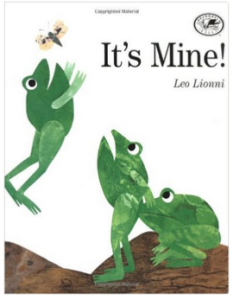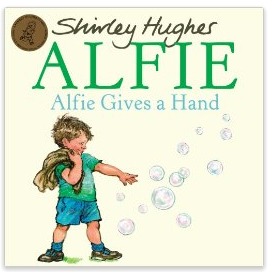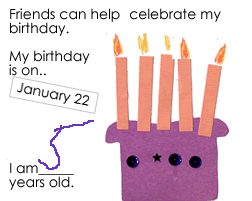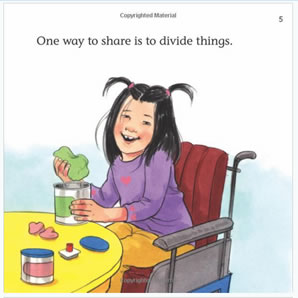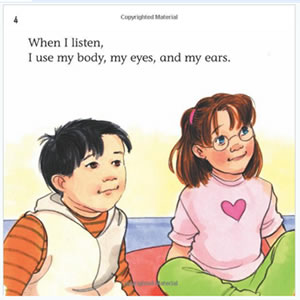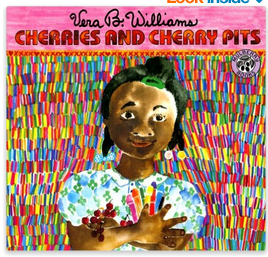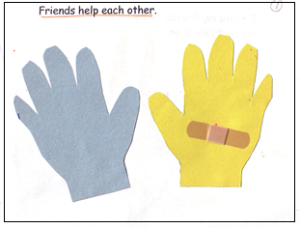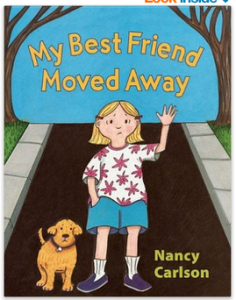Making Friends One Day at a Time, teacher guide for days 6 – 12
For little kids, making friends can be a challenge. They must deal with resolving arguments, overcoming shyness, responding to more aggressive children and more. Showing respect, responsibility, and stewardship are social skills that all children need to learn over time.
“Making Friends One Day at a Time”, helps children to be more aware of what they can do to build friendships. The teacher guide for days six through twelve is below.
If you missed downloading the free student pages, you can find them here….
If you’re looking for the teacher instructions for Days 1 -5 go here…
Day 6 – Friends can share. I can share my…
Read: It’s Mine! by Leo Lionni
It’s Mine! is another wonderful Leo Lionni book. Three selfish frogs live together on an island in the middle of Rainbow Pond. All day long they bicker: It’s mine! It’s mine! It’s mine! But a bad storm and a big brown toad help them realize that sharing is much more fun. With characteristic clarity, simplicity, and exuberance, Leo Lionni makes it possible for kids to see themselves through the antics of others who share our world.
Talk: Friends can share. I can share my…
- Post some pictures of everyday items (toothbrush, jacket, ball, comb, teddy bear, toys) where children can see them.
- Classify the items into two groups. I can share these items. I don’t share these items.
- Talk about why you do or do not share them.
- Toys are precious to children and even adults aren’t expected to share their special things on a daily basis.
- A classroom is a great place to teach sharing because the items do not belong to the children.
- Sharing is taught by modeling generosity and helping children to develop empathy.
- Vocalize feelings with puppets or role-playing to help children be aware of how their friends might be feeling when they don’t get turns.
Song: The Sharing Song by Raffi
It’s mine but you can have some, With you, I’d like to share it
Cause if I share it with you,
You’ll have some too
Well if I have a cake to eat, If I have a tasty treat
If you come to me and ask I’ll give some to you
It’s mine but you can have some With you Id like to share it
Cause if I share it with you,
You’ll have some too
And if I have a book to read If I have a book you need
If you come to me and ask I’ll share it with you
Student Activity in the booklet: Friends can share. I can share my…
Materials and instructions are in the “Making Friends One Day at a Time”, student pages download.
Day 7 – Friends can help me celebrate my birthday
Read: Alfie Gives a Hand by Shirley Hughes
by Shirley Hughes
Alfie is excited when he is invited to Bernard’s birthday party, though he feels a bit nervous about going on his own. But Alfie has such a great time that he finds he doesn’t even need his special blanket—and he makes a new friend too!
Talk: About birthday parties
Birthday parties can be stressful for little kids making friends. Encourage kids to share likes and dislikes about birthday parties so they realize that they are not the only ones who have those feelings.
Talk about:
- how you might feel if you are not invited to a birthday party
- how parents have to limit how many children are invited to a birthday party
- how it is kind not to talk about the party at school if only some of the children are invited
Game: Freeze Up
Just for fun play a birthday party game called, Freeze Up. Play music and tell the kids to move to the music while it is going and freeze and hold their position as soon as the music stops (demonstrate first). Each time you stop the music, wait for a moment before you restart it to give the children a chance to look at each other.
Student Activity in the booklet: Friends can help celebrate my birthday
Materials and instructions in “Making Friends One Day at a Time” student pages download.
Day 8 – My friends and I are the same in some ways.
Read: Margaret and Margarita / Margarita y Margaret  by Lynn Reiser
by Lynn Reiser
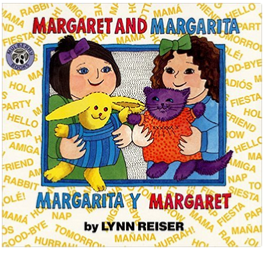
Margaret and Margarita are two children, one that speaks Spanish and one that speaks English meet at a park. The little girls gesture and play with their toys, each picking up a few words of the other’s language and part as friends.
Talk: Point out that friends may look different in some ways and yet be the same in many ways.
Young children can be unwelcoming to kids in the class who look different. Emphasize that although we are all different in appearance, we are all the same in many ways and we can be friends.
Try this activity to help:
- Have students sit in a circle
- Call out, “Children that – have pets, (live in apartments, live in houses, have brothers, have sisters, walk to school, take a bus to school, who like laughing, anything that is not about physical appearances), stand up.
- Children who are the same in any category stand up.
- Repeat with different criteria.
Talk about:
- we are all different in a few ways but we are the same in many ways
- how we can help all friends feel accepted or part of the group
Game: Ring the Bell
- Divide the children into 2 groups
- Give each child in one group a simple, short, book like the ones in the image
- Ring a bell
- Invite children with the book to find someone to stand beside who has different hair than themselves …
- The two children then sit together and look at the book together
- The child with the book now gives his/her book to the other child
- Ring the bell again and repeat, having the new group of children with books pick a new friend who has different eye color than themselves and then they read the book together
- Depending on the group you may continue this for another round.
Student Activity in the booklet: My friends and I are the same in many ways.
Materials and instructions in “Making Friends One Day at a Time” student pages download.
More Books to Develop Inclusiveness
It’s Okay To Be Different by Todd Parr teaches us that it’s okay to be different.The illustrations are bright, colorful for reading aloud. Children are reminded that it’s okay to be different, no matter what their differences or similarities. Self-acceptance is the most important message and this is a great book for showing children that differences are perfectly fine and acceptable.
From the, “It’s okay to be adopted” illustration of a kangaroo with a puppy in her pouch to the, “It’s okay to eat macaroni and cheese in the bathtub”, kids of every shape, size, color, family makeup, and background will feel included in this gentle, witty book.
Accept and Value Each Person is a book about accepting and valuing people who are different from oneself and one’s immediate family. Kids making friends learn about respecting differences and appreciating people.
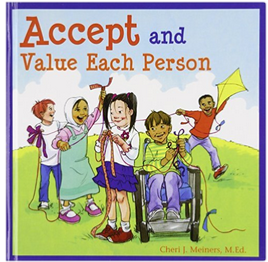
The book by Cheryl Meiners, is one of a series on character development. The pictures are not too busy and illustrate one concept at a time.
Meiner believes that character development is the basis for personal growth, the foundation for lifelong learning and that children are happier, more caring, more forgiving, and more responsible as they are taught to think about the needs of others.
The series is called “Learning to Get Along”. Some other titles include:
- Be Polite and Kind
- Cool Down and Work Through Anger
- Join In and Play
- Know and Follow Rules
- Listen and Learn
- Share and Take Turns
- Talk and Work It Out
Talk about:
- How we are the same and how we are different. Be sensitive to children who are the only different one in a group, for example, the only one with red hair. Children can easily get upset when they feel singled out.
- That feeling different can be a good feeling. It can make us feel proud of ourselves or happy, such as if we are the only one that can run as fast as the grade 2 kids
- What is self-acceptance? How it is a good feeling.
- How feeling different can make us feel conspicuous or noticed a lot.
- How everybody, even adults, feel different sometimes.
Day 9 – Friends help each other
Read: Cherries and Cherry Pits by Vera B. Williams
by Vera B. Williams
A beautifully illustrated book about sharing. Bidemmi, a little girl who loves to draw, makes up all kinds of imaginative stories about the fascinating people she creates in her artwork.
Game: Helper Tower
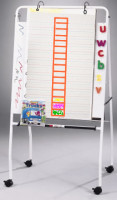
- Draw a tall tower out on a sheet of lined chart paper, then add some lines to make blocks (see image )
- Tell the children that every time they do something to help another classmate, they are to come to the tower and color one block.
- Set a timer and when it goes off, count how many blocks high they made the tower by helping each other.
Student Activity in the booklet: Friends help each other
Materials and instructions in “Making Friends One Day at a Time” student pages download.
Day 10 – Show how you can be a good friend. Thinking about what we’ve learned
Game: Name line
- Get everyone to stand in a line or limit it to 6 children or so at a time.
- The first person says their name.
- The second person then says their name, as well as the name of the person who just said their name.
- As the children learn the names make the game harder by having them remember all the names from the beginning of the line.
- Many children will need prompts. Keep it fun!
Student Activity in the booklet: Draw a picture to show how you can be a good friend
Materials and instructions in “Making Friends One Day at a Time” student pages download. Review these tips for kids making friends
Day 11 – Sometimes friends move away
Most children eventually experience a friend moving away. This page in the booklet is about keeping in contact with friends and family who move away or who live far away.
Read: My Best Friend Moved Away by Nancy Carson
My Best Friend Moved Away – Many young children will have experienced a friend or family member moving away. The girl in this story has had good and bad experiences with her friend next door before the family moved away. Now she is feeling lost and sad. She doesn’t know if she will have a good friend again.
Talk: When friends and family live far away.
Have kids share if any of their friends or family have moved away or live far away. Children can talk about different ways they keep in touch with their friends or relatives (Skype, phone, letters, photos, emails…).
Talk about how people feel when someone moves away. Help them put words to their feelings of loss.
It is okay to be sad and miss your friend. Everyone experiences loss and feels sad sometimes. When they are feeling sad they can talk to someone, draw, play games and listen to music. Be positive and ensure them that they will make new friends.
Art therapy is a wonderful way to help children express their feelings.
Student Activity in the booklet: When my friend moves away, I can…
Materials and instructions in “Making Friends One Day at a Time” student pages download.
Day 12 – These are the names of my new friends
Hopefully, by Day 12, students will have learned many of their classmates’ names. This activity will give the children an opportunity to review their friends’ names when they take their friendship book home. They can read it to their parents and have it read back to them.
Read: The Name Jar
The Name Jar by Yangsook Choi – This book is about being the new kid in school and having a name no one can pronounce. Having just moved from Korea, Unhei is anxious that American kids will like her. So instead of introducing herself on the first day of school, she tells the class that she will choose a name by the following week. Her new classmates are fascinated by this no-name girl and decide to help out by filling a glass jar with names for her to pick from.
Game: Anne says… (variation of Simon Says_
Instead of using the name Simon in this game, the child uses his / her own name.
For example, the child whose name is, Anne, will say:
“Anne says stand up. Anne says touch your nose. Anne says wiggle your toes. Hop up and down!”
If any child follows the command, hop up and down, they have to sit down because Anne did not say her name first.
Student Activity in the booklet: List of all friends’ names, drawing with a friend
Materials and instructions in “Making Friends One Day at a Time” student pages download.
Finishing the student book
- Tidy all pages and staple.
- As a group read the books together.
Friendship Unit Posts:
6 Ways to help children make friends
Making Friends Student book Part One
Making Friends Student book Part Two
More Friendship Theme ideas
Social skills readiness tips for parents
To get a FREE printable copy of the, “Making Friends One Day at a Time”, student book pages, go to this page.
